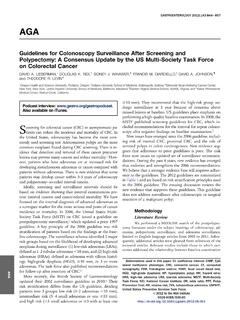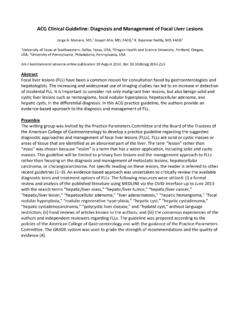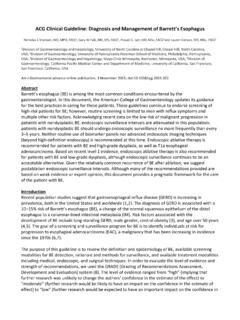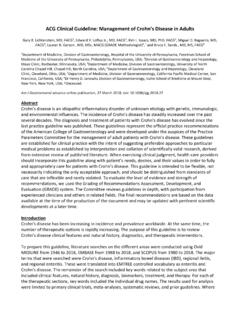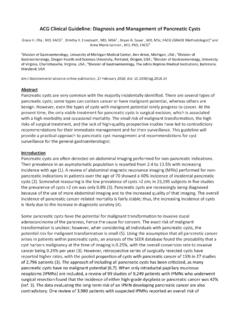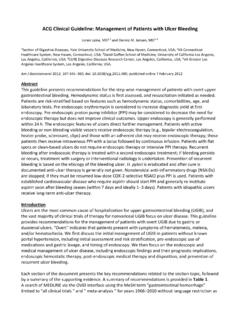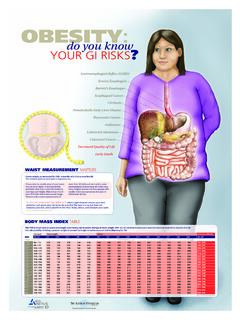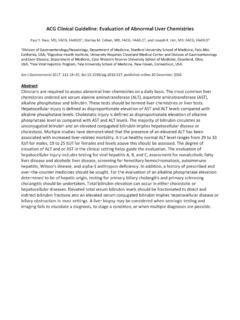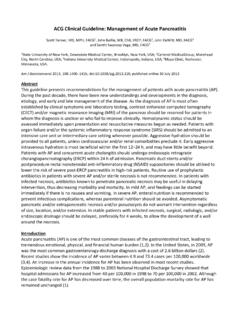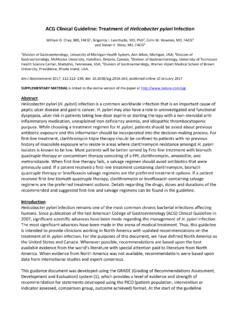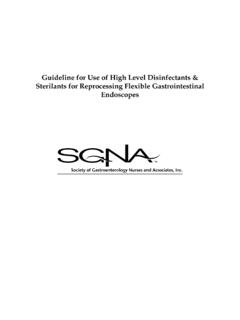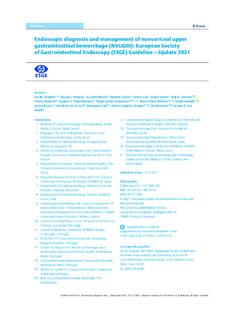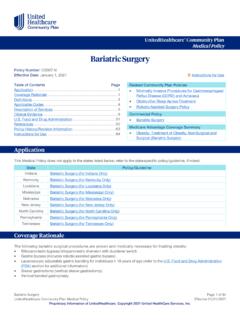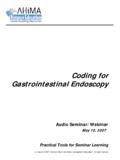Transcription of ACG & AASLD Joint Clinical Guideline: Prevention and ...
1 ACG & AASLD Joint Clinical Guideline: Prevention and Management of Gastroesophageal Varices and Variceal Hemorrhage in Cirrhosis Guadalupe Garcia-Tsao, ,1 Arun J. Sanyal, ,2 Norman D. Grace, , FACG,3 William D. Carey, , MACG,4 the Practice Guidelines Committee of the american Association for the Study of Liver Diseases and the Practice Parameters Committee of the american College of Gastroenterology 1 Section of Digestive Diseases, Yale University School of Medicine and VA-CT Healthcare System, New Haven, Connecticut; 2 Division of Gastroenterology, Virginia Commonwealth University Medical Center, Richmond, Virginia; 3 Division of Gastroenterology, Brigham and Women s Hospital, Boston, Massachusetts; 4 The Cleveland Clinic, Cleveland, Ohio Am J Gastroenterol 2007;102:2086 2102 Abstract These recommendations provide a data-supported approach to the management of patients with varices and variceal hemorrhage. They are based on the following: (1) formal review and analysis of the recently published world literature on the topic (Medline search); (2) several consensus conferences among experts; (3) the american College of Physicians Manual for Assessing Health Practices and Designing Practice Guidelines (1); (4) guideline policies, including the american Association for the Study of Liver Diseases Policy Statement on Development and Use of Practice Guidelines and the american Gastroenterological Association s Policy Statement on the Use of Medical Practice Guidelines (2); and (5) the authors years of experience caring for patients with cirrhosis and varices.
2 Intended for use by healthcare providers, these recommendations suggest preferred approaches to the diagnostic, therapeutic, and preventive aspects of care. As with other practice guidelines, this guideline is not intended to replace Clinical judgment but rather to provide general guidelines applicable to the majority of patients. They are intended to be flexible, in contrast to standards of care, which are inflexible policies designed to be followed in every case. Specific recommendations are based on relevant published information. To more fully characterize the quality of evidence supporting recommendations, the Practice Guidelines Committee of the AASLD requires a class (reflecting benefit versus risk) and level (assessing strength or certainty) of evidence to be assigned and reported with each recommendation (Table 1, adapted from the american College of Cardiology and the american Heart Association Practice Guidelines (3, 4)).
3 When little or no data exist from well-designed prospective trials, emphasis is given to results from large series and reports from recognized experts. Further controlled Clinical studies are needed to clarify aspects of this statement, and revision may be necessary as new data appear. Clinical considerations may justify a course of action that differs from these recommendations. These recommendations are fully endorsed by the american Association for the Study of Liver Diseases and the american College of Gastroenterology. Introduction Portal hypertension is a progressive complication of cirrhosis. Therefore, the management of the patient with cirrhosis and portal hypertensive gastrointestinal bleeding depends on the phase of portal hypertension at which the patient is situated, from the patient with cirrhosis and portal hypertension who has not yet developed varices to the patient with acute variceal hemorrhage for whom the objective is to control the active episode and prevent rebleeding.
4 Practice guidelines for the diagnosis and treatment of gastroesophageal variceal hemorrhage, endorsed by the american Association for the Study of Liver Diseases ( AASLD ), american College of Gastroenterology (ACG), american Gastroenterological Association (AGA), and american society of gastrointestinal Endoscopy (ASGE), were published in 1997 (5). Since then, a number of randomized controlled trials have advanced our approach to managing variceal hemorrhage. Three international consensus conferences have been held (Baveno III in 2000, Baveno IV in 2005, and an AASLD /EASL single topic conference in 2007) in which experts in the field have evaluated the changes that have occurred in our understanding of the pathophysiology and management of gastroesophageal hemorrhage (6, 7). In this updated practice guideline we have reviewed the randomized controlled trials and meta-analyses published in the last decade and have incorporated recommendations made by consensus.
5 Table 1. Grading System for Recommendations Classification Description Class I Conditions for which there is evidence and/or general agreement that a given diagnostic evaluation, procedure or treatment is beneficial, useful, and effective. Class II Conditions for which there is conflicting evidence and/or a divergence of opinion about the usefulness/efficacy of a diagnostic evaluation, procedure or treatment. Class IIa Weight of evidence/opinion is in favor of usefulness/efficacy. Class IIb Usefulness/efficacy is less well established by evidence/opinion. Class III Conditions for which there is evidence and/or general agreement that a diagnostic evaluation/procedure/treatment is not useful/effective and in some cases may be harmful. Level of Evidence Description Level A Data derived from multiple randomized Clinical trials or meta-analyses. Level B Data derived from a single randomized trial, or nonrandomized studies. Level C Only consensus opinion of experts, case studies, or standard-of-care.
6 NATURAL HISTORY OF VARICES Table 2. Child-Pugh Classification of the Severity of Cirrhosis Points* 1 2 3 Encephalopathy None Grade 1 2 (or precipitant-induced) Grade 3 4 (chronic) Ascites None Mild/Moderate (diuretic-responsive) Tense (diuretic-refractory) Bilirubin (mg/dL) <2 2 3 >3 Albumin (g/dL) > < PT (sec prolonged) or INR <4 4 6 >6 < > *5 6 points: Child A 7 9 points: Child B 10 15 points: Child C Rationale for the Management of Varices Table 3. Effect on Portal Flow, Resistance and Pressure with the Different Therapies for Varices/Variceal Hemorrhage Treatment Portal Flow Portal Resistance Portal Pressure Vasoconstrictors ( -blockers) Venodilators ( nitrates) * Endoscopic therapy TIPS/Shunt therapy *Although theoretically nitrates act by decreasing resistance, they actually act by decreasing portal flow through a decrease in mean arterial pressure. Summary of recommendations Diagnosis of Varices and Variceal Hemorrhage 1.
7 Screening esophagogastroduodenoscopy (EGD) for the diagnosis of esophageal and gastric varices is recommended when the diagnosis of cirrhosis is made (Class IIa, Level C). 2. On EGD, esophageal varices should be graded as small or large (>5 mm) with the latter classification encompassing medium-sized varices when 3 grades are used (small, medium, large). The presence or absence of red signs (red wale marks or red spots) on varices should be noted (Class IIa, Level C). A. Patients with Cirrhosis and No Varices 3. In patients with cirrhosis who do not have varices, nonselective -blockers cannot be recommended to prevent their development (Class III, Level B). 4. In patients who have compensated cirrhosis and no varices on the initial EGD, it should be repeated in 3 years (Class I, Level C). If there is evidence of hepatic decompensation, EGD should be done at that time and repeated annually (Class I, Level C). B. Patients with Cirrhosis and Small Varices That Have Not Bled 5.
8 In patients with cirrhosis and small varices that have not bled but have criteria for increased risk of hemorrhage (Child B/C or presence of red wale marks on varices), nonselective -blockers should be used for the Prevention of first variceal hemorrhage (Class IIa, Level C). 6. In patients with cirrhosis and small varices that have not bled and have no criteria for increased risk of bleeding, -blockers can be used, although their long-term benefit has not been established (Class III, Level B). 7. In patients with small varices that have not bled and who are not receiving -blockers, EGD should be repeated in 2 years (Class I, Level C). If there is evidence of hepatic decompensation, EGD should be done at that time and repeated annually (Class I, Level C). In patients with small varices who receive -blockers, a follow-up EGD is not necessary. Summary of recommendations continued C. Patients with Cirrhosis and Medium/Large Varices That Have Not Bled 8.
9 In patients with medium/large varices that have not bled but have a high risk of hemorrhage (Child B/C or variceal red wale markings on endoscopy), nonselective -blockers (propranolol or nadolol) or EVL may be recommended for the Prevention of first variceal hemorrhage (Class I, Level A). 9. In patients with medium/large varices that have not bled and are not at the highest risk of hemorrhage (Child A patients and no red signs), nonselective -blockers (propranolol, nadolol) are preferred and EVL should be considered in patients with contraindications or intolerance or non-compliance to -blockers (Class I, Level A). 10. If a patient is placed on a nonselective -blocker, it should be adjusted to the maximal tolerated dose; follow-up surveillance EGD is unnecessary. If a patient is treated with EVL, it should be repeated every 1 2 weeks until obliteration with the first surveillance EGD performed 1 3 months after obliteration and then every 6 12 months to check for variceal recurrence (Class I, Level C).
10 11. Nitrates (either alone or in combination with blockers), shunt therapy, or sclerotherapy should not be used in the primary prophylaxis of variceal hemorrhage (Class III, Level A). D. Patients with Cirrhosis and an Acute Episode of Variceal Hemorrhage 12. Acute GI hemorrhage in a patient with cirrhosis is an emergency that requires prompt attention with intravascular volume support and blood transfusions, being careful to maintain a hemoglobin of ~8 g/dL (Class I, Level B). 13. Short-term (maximum 7 days) antibiotic prophylaxis should be instituted in any patient with cirrhosis and GI hemorrhage (Class I, Level A). Oral norfloxacin (400 mg BID) or intravenous ciprofloxacin (in patients in whom oral administration is not possible) is the recommended antibiotic (Class I, Level A). In patients with advanced cirrhosis intravenous ceftriaxone (1 g/day) may be preferable particularly in centers with a high prevalence of quinolone-resistant organisms (Class I, Level B).
